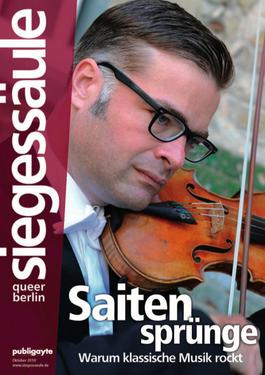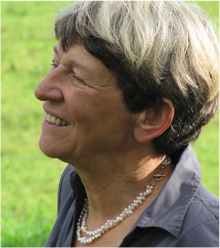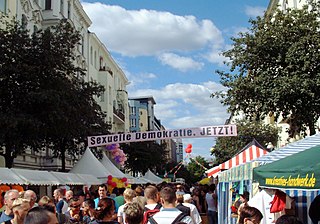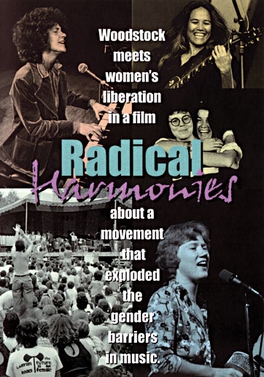
Barbara Jean Hammer was an American feminist film director, producer, writer, and cinematographer. She is known for being one of the pioneers of the lesbian film genre, and her career spanned over 50 years. Hammer is known for having created experimental films dealing with women's issues such as gender roles, lesbian relationships, coping with aging, and family life. She resided in New York City and Kerhonkson, New York, and taught each summer at the European Graduate School.
Diana E. H. Russell was a feminist writer and activist. Born and raised in Cape Town, South Africa, she moved to England in 1957, and then to the United States in 1961. For the past 45 years she was engaged in research on sexual violence against women and girls. She wrote numerous books and articles on rape, including marital rape, femicide, incest, misogynist murders of women, and pornography. For The Secret Trauma, she was co-recipient of the 1986 C. Wright Mills Award. She was also the recipient of the 2001 Humanist Heroine Award from the American Humanist Association. She was also an organizer of the First International Tribunal on Crimes against Women, in Brussels in March 1976.
Women's music is a movement, chiefly in Western popular music, said to promote music "by women, for women, and about women". The genre emerged as a musical expression of the second-wave feminist movement as well as the labor, civil rights, and peace movements. The movement was started by lesbian performers such as Cris Williamson, Meg Christian and Margie Adam, African-American musicians including Linda Tillery, Mary Watkins, Gwen Avery and activists such as Bernice Johnson Reagon and her group Sweet Honey in the Rock, and peace activist Holly Near. Women's music also refers to the wider industry of women's music that goes beyond the performing artists to include studio musicians, producers, sound engineers, technicians, cover artists, distributors, promoters, and festival organizers who are also women.
The Deadly Nightshade is a New England–based rock and country trio consisting of members Anne Bowen, Pamela Brandt, and Helen Hooke, who originally began performing under the name Ariel in 1967, along with Gretchen Pfeifer and Beverly Rodgers. It was one of the earliest all-women rock bands signed to a major label, and an early women's music group. Some early members of the group originally performed as the Moppets.

Siegessäule is Berlin's most widely distributed queer magazine and has been published monthly, except for two brief hiatuses, since April 1984. Originally only available in West Berlin, it ran with the subtitle "Berlin's monthly page for Gays". In 1996, it was broadened to include lesbian content, and in 2005 it was expanded to reach a wider queer target base, becoming the only magazine of its scale in Europe to represent the full spectrum of the LGBT community. The magazine is available for free at around 700 locations in Berlin, printing 53.688 copies per month. Since March-issue 2013, it has been overseen by chief editor Jan Noll.

The SO36 club is a music club on Oranienstraße near Heinrichplatz in the area of Kreuzberg in Berlin, Germany.

The Schwules Museum in Berlin, Germany, is a museum and research centre with collections focusing on LGBTQ+ history and culture. It opened in 1985 and it was the first museum in the world dedicated to gay history.

Not Bad for a Girl is a documentary on women musicians of the 1990s from the indie rock music genre grunge and riot grrrl and celebrates madness, creativity, and gender play. It was written, directed, produced and shot by rock phenomenologist feminist Lisa Rose Apramian, edited, shot and co-produced by drummer Kyle C. Kyle and co-produced by Courtney Love and Kurt Cobain. A DVD, with a booklet, was available for purchase at the official website and a release date for the sequel book is still in the works as of 2019.

Renée Sintenis, née Renate Alice Sintenis, also known as Frau Emil R. Weiss, was a German sculptor, medallist, and graphic artist who worked in Berlin. She created mainly small-sized animal sculptures, female nudes, portraits, and sports statuettes. She is especially known for her Berlin Bear sculptures, which was used as the design for the Berlinale's top film award, the Golden Bear.

The Feminist Improvising Group (FIG) were a five- to eight-piece international free improvising avant-garde jazz and experimental music ensemble formed in London in 1977 by Scottish vocalist Maggie Nicols and English bassoonist/composer Lindsay Cooper. Their debut performance was at a "Music for Socialism" festival at the Almost Free Theatre in London in October 1977, and they toured Europe several times in the late 1970s and early 1980s.

Manuela Kay is a German journalist, author and publisher.

Cristina Perincioli is a Swiss film director, writer, multimedia producer and webauthor. She moved to Berlin in 1968. Since 2003 she has lived Stücken in Brandenburg.

Cäcilia (Cillie) Rentmeister is a German art historian, culture scientist and researcher of cultural conditions of women and of gender. In addition to studying the different realities in which men and women are living, she has concerned herself with the matriarchy.
Suman Sridhar is a singer, songwriter, and actor. Sridhar works in music, performance art, theatre and film. Suman is trained in Bharat Natyam classical dance and Indian Classical music and studied Western Classical Music, Women's & Gender Studies and Visual Arts from Mason Gross Rutgers University, USA. Suman has sung chart topping Bollywood film songs. Her performances include venues like National Centre for the Performing Arts (India), Southbank Centre (UK), BBC- World Service (UK), MTV India, Sound Trek, NH7 Weekender (India), Radio Mirchi Music Awards (India), Mijwan Fashion Show (India), Jazzmandu (Nepal), Galle Literary Festival, The Quarter: Royal Opera House (India), The Great Escape Festival (UK), One Billion Rising (India) etc.

Berlin was the capital city of the German Empire from 1871 to 1945, its eastern part the de facto capital of East Germany from 1949 to 1990, and has been the capital of the unified Federal Republic of Germany since June, 1991. The city has an active LGBT community with a long history. Berlin has many LGBTIQ+ friendly districts, though the borough of Schöneberg is widely viewed both locally and by visitors as Berlin's gayborhood. Particularly the boroughs North-West near Nollendorfplatz identifies as Berlin's "Regenbogenkiez", with a certain concentration of gay bars near and along Motzstraße and Fuggerstraße. Many of the decisive events of what has become known as Germany's second LGBT movement take place in the West Berlin boroughs of Charlottenburg, Schöneberg, and Kreuzberg beginning in 1971 with the formation of the Homosexuelle Aktion Westberlin (HAW). Where as in East Berlin the district of Prenzlauer Berg became synonymous with the East Germany LGBT movement beginning in 1973 with the founding of the HIB. Schöneberg's gayborhood has a lot to offer for locals and tourists alike, and caters to, and is particularly popular with gay men. Berlin's large LGBT events such as the Lesbian and Gay City Festival, East Berlin Leather and Fetish Week, Folsom Europe, and CSD center around Schöneberg, with related events taking place city-wide during these events. Nevertheless, with roughly 180 years of LGBTIQ+ history, and a very large community made up of members with very varied biographies, it is hard to find a place in Berlin completely without LGBT culture past or present. Berlin's present-day neighborhoods with a certain concentration of LGBTIQ+ oriented culture vary somewhat in terms of history, demography, and where the emphasis in each neighborhoods' queer culture falls along the LGBTIQ+ spectrum. Over the course of its nearly two centuries of queer history (herstory), definitions not with standing, Berlin's LGBTIQ+ culture has never ceased to change, not only in appearance and self-understanding, but also in where the centers of queer culture were located in the city. What is true about Berlin's "LGBT culture in Berlin" at one point in time, in a given place and from a given perspective, is almost certainly different the next.

Women have made significant contributions to punk rock music and its subculture since its inception in the 1970s. In contrast to the rock music and heavy metal scenes of the 1970s, which were dominated by men, the anarchic, counter-cultural mindset of the punk scene in mid-and-late 1970s encouraged women to participate. This participation played a role in the historical development of punk music, especially in the US and UK at that time, and continues to influence and enable future generations. Women have participated in the punk scene as lead singers, instrumentalists, as all-female bands, zine contributors and fashion designers.
Vibeke Vasbo is a Danish writer and women's rights and LGBT rights activist. In the early 1970s, she participated in the Redstocking movement and in the Danish Lesbian Movement. She embarked on a literary career in 1976 with Al den løgn om kvinders svaghed expanding on the work of a woman crane driver, based on her experiences in Oslo in 1974-75.

Kay Turner is an artist and scholar working across disciplines including performance, writing, music, exhibition curation, and public and academic folklore. She is noted for her feminist writings and performances on subjects such as women’s home altars, fairy tale witches, and historical goddess figures. She co-founded “Girls in the Nose,” a lesbian feminist rock punk band that anticipated riot grrl.

Maria Rentmeister was a German Women's and cultural policy maker - who became an anti-government resistance activist after 1933. She spent much of the time during the twelve Nazi years abroad or, later, in state detention. In 1945 she relocated to what now became the Soviet occupation zone where she became the first General Secretary of the politically important Democratic Women's League .

Radical Harmonies is a 2002 American independent documentary film directed and executive produced by Dee Mosbacher that presents a history of women's music, which has been defined as music by women, for women, and about women. The film was screened primarily at LGBTQ film festivals in 2003 and 2004.















